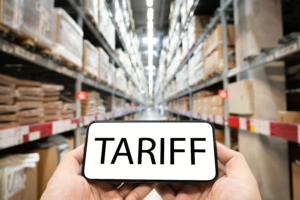
If the pandemic taught distributors anything, it was that adaptability and technology are keys to success. Technology is required to operate efficiently and compete effectively. The right solution improves customer service and helps your business save money—improving your bottom line. It will also help you weather the storm of supply chain issues, which have pushed the industry into an era of perpetual unpredictability.
3 Major Distribution Industry Trends That Should Factor into Their Planning
As you get to work on your plans to upgrade your customer experience, employee experience, operational procedures and technology, it can help to know what wholesale distribution industry trends experts are predicting for 2023. Here are three big ones.
1. Your biggest competitors will be direct-to-consumer marketplaces.
The supply chain problems created by the pandemic spooked businesses and consumers alike, with many attempting to cut wholesale distributors out of the equation entirely and attempt to sell directly to their customers. Direct-to-consumer (D2C) marketplaces have grown at astonishing rates, and that’s not expected to slow down anytime soon. D2C methods of selling include dropshipping platforms, e-commerce websites, and even social media.
So, how can your distribution company stand out from the D2C marketplaces? Again, the answer lies in leveraging technology to create exceptional customer and employee experiences, as well as support overall company performance. The right technology allows companies to demonstrate value and relevance to their customers. Wholesale distributors who are leaders in online selling have strong data forecasting abilities. They also use technology to improve logistics and cut down on customer wait times. They are the ones who will beat their direct-to-consumer competitors and thrive in 2023.

2. B2B personalization is essential to staying in business.
You may have heard this term crop up in the last few years: “B2B personalization.” It’s a major buzzword in the distribution industry that means your business customers expect you to understand their individual needs. But demonstrating knowledge of their overall industry is no longer sufficient. You’ll need to offer them personalized prices, rebates, and even discounts that map to their unique operational circumstances. And they’ll expect to communicate with you via their preferred channel. By “preferred channel,” industry trends indicate that video, in-person meetings, and e-commerce platforms are the top communication paths to focus on. To stay competitive, your distribution business will need to offer, and be adept at working with customers through, all three of these communication modes. This is your cue to incorporate video into your business and optimize that e-commerce web platform now.
In a world where technology most often removes the human element from our business dealings, it’s more important than ever to find ways to use technology to enhance the human connection. People buy from people. Relationships matter. Your supplier is more likely to prioritize your orders if they know you. Your customers are more likely to remain loyal to your business if they have a personal connection.
Video conferencing is pervasive in the world today and while it comes with pitfalls, companies should be leveraging it throughout their organizations to foster person-to-person connections with suppliers and customers. While your competitors are automating people out of the equation, set your business apart by using technology to bring the human connection back.
3. Distributors need to get on board with omnichannel selling.
Omnichannel selling, or the practice of selling your products both online and off, is one area where the distribution industry is lagging. The retail industry, for instance, was an early adopter of omnichannel selling, and many companies have stayed in business, expanded their customer base, and increased their profits because of it. This method of doing business has been successful because of its customer-centric approach, which has proved to be an advantage in a world where consumers can get on their mobile devices and educate themselves and place orders without salesperson input.
Here, technology is the essential ingredient for distributors to effectively compete with D2C marketplaces—and even with traditional retailers. Customers expect an exceptional buying experience no matter how they interact with your business, whether it’s in person, on your e-commerce platform, via social media, or in a video chat meeting. You need to ensure that no matter how customers choose to work with you, their experience is seamless and lives up to the new generation’s expectations. To achieve this goal, personalization is key: The modern consumer wants their data to be shared across all the platforms a company uses so they can view their order history, store credit cards, and enjoy easy shopping each time they buy something from you. By adopting and implementing a technology solution that is intuitive for end users, incorporating results-driven business intelligence, and producing insights that focus on your core business objectives, you’ll succeed in this endeavor. The right technology solution will help you adapt to changing business landscapes—and even predict and correct problems before they spiral out of control and cause operations, profitability, and growth.
Distributors Need Technology to Improve Their Bottom Line
Ultimately, your strategy for success in the distribution industry needs to address multiple issues:
- Adopting technology
- Creating a customer-centric experience that is both seamless and personalized
- Measuring your company’s performance via distribution KPIs
- Understanding the data your tech solution provides so you can make informed decisions
- Delivering a positive employee experience that allows you to retain your team and attract top talent
- Selling across multiple channels to retain customers and attract new ones
While this list may seem intimidating, having the right technology selection and implementation strategy sets you up to allocate your limited time and money in the most efficient way to achieve your objectives. Setting your priorities, educating and empowering your employees, understanding your customers, and implementing a goals-based framework—taking action in these four areas is how distributors like you thrive in today’s economy.







